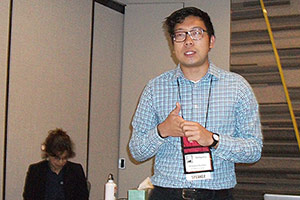As California goes, so goes the rest of the country.
That adage has often proved true especially when it comes to regulations related to refrigeration and refrigerants. The aggressive environmental and regulatory positions in Sacramento, California, have caused the rest of the United States to monitor policy making and enforcement out West. And, more often than not, those policies have ended up as the blueprint for federal regulations.

|
| California Air Resources Board’s Satapana Buthken talks regulatory changes regarding refrigeration and refrigerants. |
Attendees from throughout the U.S., Canada, and several other countries were at the most recent RSES International Conference in Long Beach, California, and heard the latest during a seminar on the Refrigerant Management Program of the California Air Resources Board (CARB).
Satapana Buthken of CARB noted regulatory developments related to refrigeration systems using more than 50 lbs. of high global warming potential (GWP) HFC refrigerant. “Businesses affected are cold storage warehouses, distribution facilities, ice rinks, supermarkets, oil/gas production sites, and manufacturing,” said Buthken. “Bars, restaurants, and gas stations are generally not affected by this rule (due to smaller charges).”
He noted the need for registration of such equipment with the state, and explained requirements that technicians at facilities affected conduct periodic leak inspections, repair leaks within 14 days of detection, keep records of service and refrigerant transactions, and follow required service practices.
Proper maintenance focuses on the need for automatic leak detection for larger systems (greater than 2,000-lb. charge) and quarterly leak inspections, while medium size systems (200 to 1,500 lbs.) require quarterly leak inspections, and small systems (50 to 199 lbs.) need annual leak inspections.
Portions of the talk spoke specifically to service technicians who were warned, for example, “not to add an additional refrigerant charge to any appliance known to have a refrigerant leak” until that leak was repaired.
Enforcing
The issue of how to enforce the regulations was discussed by Bradley McClung, an inspector for the South Coast Air Quality Management District. He noted that his is one of 35 such districts in California to monitor compliance.
In the mix, he said, was facility registration every two years for air conditioning systems and every year for refrigeration facilities. In addition to aspects noted by Buthken, McClung said a “retirement” plan is needed for equipment.
There are a number of aspects to consider in preparation for inspections, such as:
• A verification of the system should be performed before any refrigerant is added.
• Failure to use recovery and recycling equipment is a violation.
• Manifests should be maintained for transportation and disposal of refrigerants.
Ombudsman
There are reasons for all the regulations, said Jenna Latt, who is in the Office of Ombudsman for CARB. “We want to reduce emissions of refrigerants with a high global warming potential. We want to create a level playing field. And we want to deter future non-compliance. The regulation is enforced.”
The Office of Ombudsman was created, she said, to help businesses deal with the regulatory expectations. There are, she said, “resources such as permitting assistance, financial assistance, and training courses.”
Benefits to compliance she said were ability “to save money annually on refrigerants, save energy and increase energy efficiency, help reduce greenhouse gas emissions that contribute to climate change, and ensure compliance with the law.”
Latt also noted the ongoing issue at the time of her presentation at the RSES conference in which the U.S. Environmental Protection Agency was proposing to de-certify within its Significant New Alternatives Program (SNAP) a number of perceived high GWP HFC refrigerants, most for refrigeration applications.
Latt also drew attention to a growing list of what she described as “alternative refrigerants” with a low GWP of less than 150. These included R-744 (carbon dioxide) and R-717 (ammonia) as well as the hydrocarbons R-290 (propane), R-600a (isobutene), R-1270 (propylene), and R-170 (ethane).
Latt cited a number of considerations when dealing with such refrigerants:
• There is no drop-in, one size fit all solution.
• Carbon dioxide systems — particularly transcritical CO2 systems — are being used with increasing frequency.
• Ammonia has the benefit of being both energy efficient and having zero impact on both climate change and the ozone layer, but the toxicity factor should be considered.
• Hydrocarbon systems are limited to 150 grams. (Editor’s Note: This was at the time of the presentation, but the EPA has been considering raising that limit to 300 grams.)



Report Abusive Comment